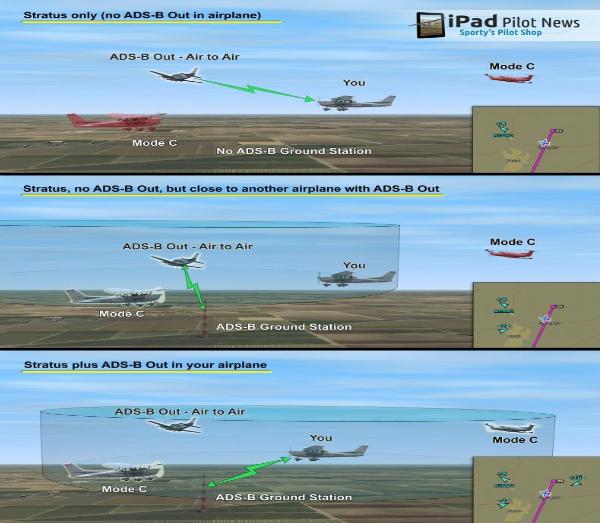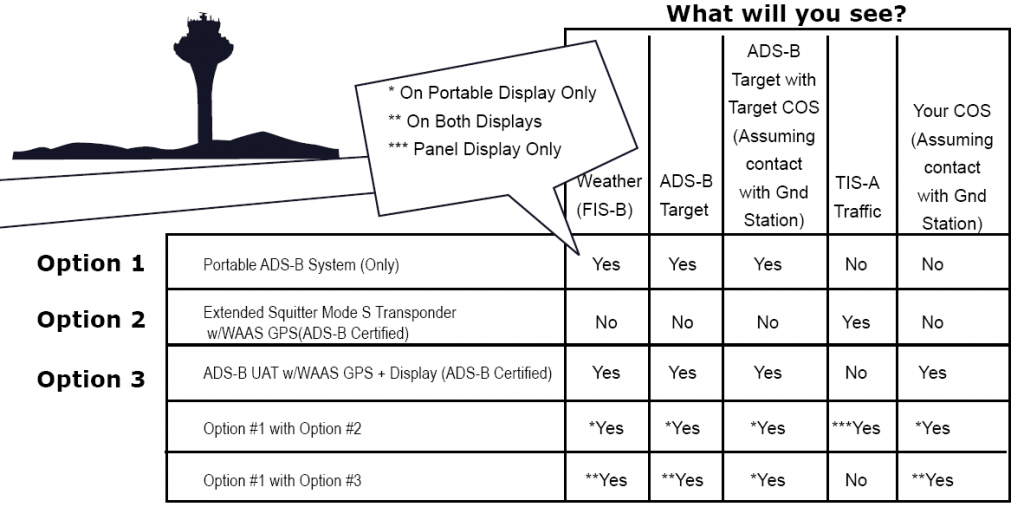Automatic Dependent Surveillance Broadcast - ADSB
The ADS-B wave has gone however there are still some aircraft out there that may need to be compliant to we’ll keep this content on our website for now. Now that we know the 2020 mandate did stick, we’ll focus on Who needs it & What does it cost?
My experience on this subject, which goes back to the infancy of a project which started out as the “Capstone
Program”, tells me that the biggest hurdle (aside from cost) has been the lack of understanding of how an aircraft
owner gets from here to there on equipage. There are plenty of articles telling you what ADS-B is and how it works so
I won’t deal heavily with this issue in this article. The purpose of this article is to get down to the basics of ADSB. My hope is that I can apply the K.I.S.S. method to provide a basic understanding of what is needed and the pros/
cons to your choices. These choices will include portable/uncertified equipment and certified equipment.
Minimum Requirements:
- Certified WAAS GPS Receiver
There are not, and most likely will never be, any ADS-B solutions, certified or uncertified that will meet the ADS-B Mandate without a Certified WAAS GPS Receiver for a Type Certificated Aircraft. Exceptions have been made to accommodate the non-certificated aircraft market provided the uncertified equipment meets certain performance characteristics. Your options range from a Panel Mounted WAAS GPS Receiver, to an independent Remote Mounted WAAS GPS Receiver (a.k.a. ‘a black box), or a WAAS GPS Receiver that is built-in as part of the ADS B solution (UAT or Transponder). - ADS-B Solution
You have the choice of an ADS-B UAT (the uAvionix product line is considered a UAT) or a Mode S Transponder with Extended Squitter (ES).
Note: UAT may be used at any flight level, however, if you intend on flying above 18,000 Ft., out of the country where Model S is required, have SPECIAL Mission applications, OR using the aircraft for Part 135 operations, you must have a MODE S w/ES Transponder whether or not you have an ADS-B UAT.
ADS-B Out vs. ADs-B IN:
ADS-B Out is the ability to transmit a properly formatted ADS-B message from the aircraft to ground stations and to other ADS-B In equipped aircraft. ADS B IN is the ability of an aircraft to receive information transmitted from ADS-B ground stations and/or from other aircraft. ADS-B IN is not mandated by the ADS-B Out rule. If an operator chooses to voluntarily equip an aircraft with ADS-B IN capability, a compatible display is also necessary to see the information. Refer to AC20-165A information on ADS-B OUT and AC20-172A information on ADS-B IN installation and certification. A compatible display can be anything from an iPad to a panel mounted display.
The merits of ADS-B are pretty simple. Every aircraft flying within Class B Airspace will need to be, at a minimum, ADS-B Out compliant. The tendency of an owner with an ADS-B OUT the only aircraft is to feel that they financed a project for the benefit of everyone else (oh…and to comply with a government mandate). The part of this mindset that gets lost in the equation is that it is just as important for others to see you as it is for you to see other aircraft.
I will concede that the merits of ADS-B IN outweigh the merits of ADS-B Out. The frugal side of me dictates that financing a mandate without reaping the total benefit of those funds spent seems like a shame. The merits of FIS-B Weather, whether through panel-mount or portable means, are pretty self-evident. FIS-B weather, either as a no-cost back-up to subscription-based datalink weather for IFR pilots or as a sole source of weather for the VFR/light IFR pilot who could never justify the costs of subscription-based datalink weather is an added bonus. TIS-B traffic, either as a blend to existing TAS/TCAS traffic systems or as a sole means of traffic, can only enhance a pilot’s awareness of what is around them. Given the availability of lower-cost portable solutions, once certified ADS-B Out equipped, every pilot has the opportunity in one configuration or another, to have something to show for the ‘pain of progress’.
Portable Solutions:
So where do the Portable ADS-B solutions come into play? The bottom line is this… The purpose of the Portable Type solutions is to provide a means of using/displaying up to three (3) types of data (FIS-B Weather, ADS-B Air-to-Air traffic, BUT beware….understand what you are buying.
Points on the Subject:

- To date, Portable solutions will ONLY provide you with two out of the three (FIS-B Weather and ADS-B Air-to-Air Traffic.) UNLESS your aircraft is otherwise certified ADS-B equipped. Why? See “How it Works” later in this article.
- Air-to-Air Traffic will ONLY be available IF you are in contact with a Mode S w/ES Transponder or
UAT ADS-B Out equipped aircraft. - Some portable systems reference traffic targets to GPS Altitude rater than Pressure Altitude. The
industry standard for TIS-A, TIS-B, TAS, and TCAS is to reference target aircraft to pressure
altitude. If your choice in a portable solution uses GPS altitude, this can translate into the altitude
of your target aircraft being as much as 700ft. off. Future upgrades may resolve this issue.
Caution: If your portable solution uses a built in sensor to determine pressure altitude, use of this
device in a pressurized aircraft simply won’t work.
The illustration specifies a Stratus portable system. From a principle of operation, this is consistent with other portable systems such as the Garmin GDL39. It is important to remember that though each system operates under the same basic premise, there are other operational differences to consider for your application. Do your homework and be satisfied!
The key to understanding the illustrations is to notice the shaded “Hockey Puck” or as I like to call it “The Cylinder of Surveillance”.
- What is it? This shaded area is the shield of data that is sent to an ADS-B Out equipped aircraft from a Ground Station. Note: You don’t ever actually “See” the Cylinder; only the traffic within it.
- How does it work? In order to provide data, the Ground Station needs to be “Pinged” to identify who you are and it needs to know WHERE you are. The ‘Ping’ is generated by the ADS-B Out equipment and the ‘Where’ is determined by your WAAS GPS (hence the need for the WAAS GPS). Your GPS provides position data to your ADS-B Equipment and your ADS-B equipment then sends your position to the ADS-B Ground Station as it ‘Pings’ the station. The Ground Station in turn, knowing where you are and what aircraft are around you, will transmit a TIS-B Cylinder of Surveillance to your ADS-B In equipment placing your aircraft right smack in the middle of the cylinder. If equipped with a complete ADS-B UAT System with display and/or an additional portable ADS-B system, your Cylinder of Surveillance will be displayed accordingly on the display. Note: This is the data that is only partially supplied or MISSING completely when equipped with ONLY a Portable type system (not ADS-B OUT compliant).
Another keynote in this discussion is to recognize that installing a new ‘ES’ transponder (or grading an existing Mode
S transponder to ‘ES’), combined with a WAAS GPS, does NOT give you a Cylinder of Surveillance, it only gives you
the SAME TIS-A traffic that would have been achieved from a non-ES Mode S transponder and that is assuming that
you are within range of one of the remaining terminal radars that support TIS-A Broadcast. However, combining this
upgrade with a portable ADS-B system WILL provide you with a Cylinder of Surveillance as displayed on your
portable display. An exception to the is the Garmin GTX345 series Transponders which are not just ADS-B OUT
compliant but also have a complete dual-band ADS-B receiver built in. See Chart Below.
For the purpose of simplifying the following chart, lets define “Cylinder of Surveillance” (Abbreviated COS) – It is
defined as the area 15nm radius and +/-3500 ft. surrounding your aircraft (or other ADS-B aircraft) which contains
traffic data.

What do you NEED and who NEEDS it?
Here’s a quick breakdown (Note: This is the ‘quick’ answer, reference FAA guidance for specifics):
- If you are flying above 18,000 Ft., operating under Part 135, or plan to fly in a country requiring it, you will need a Mode S Transporter with Extended Squitter (ES).
- If flying within Class ‘B’ Airspace after ADS-B mandate, you will need a Certified ADS-B Out w/Certified WAAS GPS for a TC’d aircraft.
Costs:
Unfortunately, given the diversity of the airframes, condition of these airframes, avionics configurations, and the constant changes within the avionics industry any attempt on my part to capture a ‘one-size fits all cost associated with these requirements would be irresponsible on my part. Again, the intent of this article is to provide a better understanding of what your options are so that you, as the aircraft owner, are in a better position to know what you need and/or want. This knowledge then empowers you to determine your costs through a trusted Avionics Shop.
Future Changes:
Since the mandate has already come and gone I don’t think there is much to say regarding about the future of ADS-B other than to say it’s here to stay. One of the questions I get asked is whether the prices will drop or not. The short answer is that the prices did not drop; in fact it has gotten more expensive.